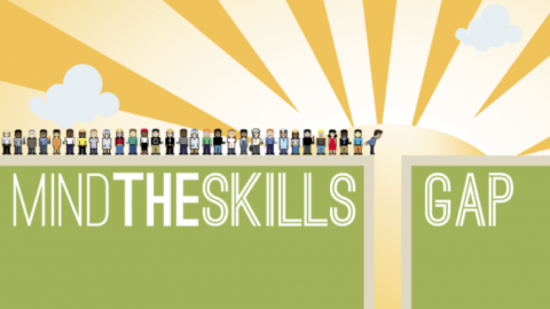In the United States, an available and consistent labor pool has been a differentiator to help manufacturing companies drive their business forward. Now we see the changing dynamics of an aging workforce that is starting to form a “perfect storm” that we need to ensure never hits our shorelines!

Our aging workforce is nearing retirement age, and we are faced with the challenge of ensuring our world class manufacturing base does not blink as we transition through these waters. We have performed valiantly to bring manufacturing back to the US shores, and we need to continue disrupting our vision and traditional thinking to keep it here!
What the skills gap looks like
- One-third of workers are over age 50 and the average age of a highly skilled manufacturing worker is 56
- Skilled trades also have far fewer 65-and-older workers than the labor force as a whole, meaning that many skilled workers aren’t holding off on retirement and the skilled worker shortage will continue for the foreseeable future.
- The U.S. could face a shortfall of about 875,000 machinists, welders, industrial machinery operators and other highly skilled manufacturing professionals by 20202
In a report by Deloitte, they call out 82% of US executives believe the upcoming skills gap will impact their implementation of new technologies and increase productivity in their manufacturing operations.
The path forward
You know it’s funny that we talk a lot about “IOT” and “Digitization” and “Disruption” and until now, there have been leaders and there have been followers in terms of embracing these paradigm shifts to the business. Early adopters of this technology revolution will be ahead of the curve as their workers retire and move to the next, and well deserved, phases of their lives.
I see the solution mainly as a two phased approach:
- The first lies in technology adoption and enabling the workers to do more tasks with greater efficiency. We talk about technology a lot, but we don’t really spend much time talking about training, education, and the necessary output we need out of our younger generation today.
- The second is a perception change of manufacturing jobs – highlighting the honor of these crucial jobs that make the luxury of the modern world possible.
Manufacturing is a tough (and very honorable) career choice since the industrial revolution. It took skills, commitment, and a work ethic second to none to get the job done, and it is woven into the American DNA. Today the manufacturing companies that are future-proofing themselves are executing a digital strategy that will accelerate them well into the future. And empowering their workers with the latest technology – the tools of today extend beyond the toolbox.
For example, have you looked at Amazon lately? Their core business model revolves around their distribution centers and logistics models, and they are world class! Amazon enables their workers to be more productive than ever before.
If we agree that we don’t have the same manufacturing environments as days gone by, then we shouldn’t have the same expectations of our upcoming youth as they are deciding what their career choices are. We often overlook the high tech trades and the amazing satisfaction that comes out of those long days building solutions that help make the world a better place.
Mike Rowe did a great job calling out the misconceptions of skilled trade jobs in this TED talk:
We gave our kids a choice, and a bachelors degree at a university was one of those choices. We also need to emphasize that trade schools are full of fantastic opportunities, ones that go beyond sitting behind a desk.
We have amazing and very high-tech trade school programs in our educational system that are affordable! If we peel the layers back, it will absolutely make a difference in the future of our country from a manufacturing perspective. We will always need the MBA to market, the PHD to design, and the sales teams to sell and help run the business. Yet we struggle without people making the products on the floor the right way.
We do not stand alone in this challenge as other countries face the same issues of an aging workforce with a slowing demographic. We do however stand tall in our ability to embrace change, stay agile, and make a difference for generations to come. I am passionate about the future we are building and want us to rethink our legacy perceptions of square pegs and rounds holes.
I feel like we have a responsibility to lead this effort with the amazing workforce we have and the technology that can arm them to future-proof our industry. This is not a moment in time, but a journey we can take together. The first step is always the hardest, but if we do it together then we move forward more efficiently and make sure neither one of us slips!
To learn more about the future of manufacturing check out our website:


My workforce coaching clients range in age from 50-75. Is there a role for them in the manufacturing industry? Many of them have undergrad degrees but are tired of the work they’ve done for 25 years. They need ongoing income. They can learn and they’re physically very capable. Look forward to learning your answer–
Mary Jo
Mary Jo:
Absolutely!!!
I think there is a work ethic, willingness to make a difference and a desire succeed “gene” in all of us. We need to find the right job that will allow these folks you are referencing to be successful and help make a difference!
As some companies re-shore back to the USA, they are not coming back the same way they left. It is a different manufacturing footprint than it was when these companies left, and these are very exciting times! The skilled workforce that is available needs to be a part of this solution, and take the knowledge they already have from years of experience and translate that to today’s manufacturing environment.
Good Blog, Steve! One thing to point out are the solutions employers are using to capture knowledge of these retiring workers like Cisco Spark. Check out this blog to see how the innovative use of this collaboration tool can help: http://blogs.cisco.com/energy/a-better-way-to-collaborate-in-industry
Thanks Scott that is great input!!!!
Steve
Great Post, it is especially useful when the author takes the time to spell out a solution in detail!
http://peakperformancesalestraining.us
Thanks for sharing the link Concetta!!